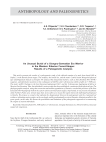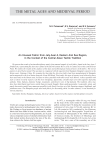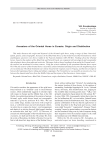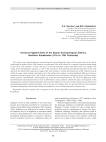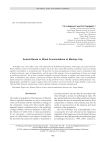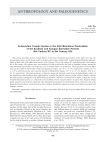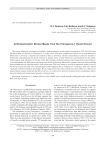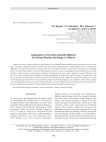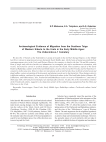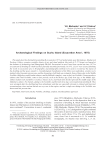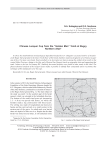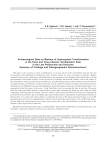Archaeology, Ethnology & Anthropology of Eurasia @journal-aeae-en
Статьи журнала - Archaeology, Ethnology & Anthropology of Eurasia
Все статьи: 524
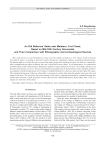
Статья научная
This study focuses on an Old Believers' skete near the village of Maltsevo, Fort Chaus, north of modern Novosibirsk, where, according to mid-18th century documents, community members committed self-immolation. Documents differ as to where the rite occurred, how many people died, and how the skete was built. As compared to other contemporaneous sketes in Russia, this one is described in more detail. To all appearances, its construction resembled that of other Siberian forts. Similarities include an outer palisade wall, up to 2.45 m high, and the use of the logwork of houses as towers. The reason behind those parallels may be that preachers and community members were familiar with the fortifi cations of Fort Chaus. Fortifi ed Old Believers' sketes are known in the Upper Ob region. The estimated living space of the log cabins fully corresponds to written data about the number of persons who took refuge in the skete. The search for the actual remains of the skete is ongoing and should be continued because this architectural structure, which existed for no more than one and a half months before the fi re (May–June 1756), is a unique site of the late 18th century.
Бесплатно
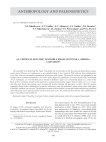
An upper Paleolithic mandible from Listvenka, Siberia: a revision
Статья научная
The mandible of a child from the Upper Paleolithic site of Listvenka in the Krasnoyarsk-Kansk forest-steppe, south-central Siberia, was subjected to a new detailed study. It was found in 1992 and was first published five years later with very incomplete information about place and context. The need for revision was prompted by the sophistication of dental trait batteries, new views of the diagnostic signifi cance of certain dental traits, availability of new techniques, etc. Now the fi nd can be related to habitation layer 12d, consistently dated to ca 13 ka on the basis of three estimates. Results of the multi-slice computed tomography suggest that the child was 3.5–4.5 years old. Like most fossils representing early anatomically modern humans, the specimen is rather robust by modern standards. Based on the combination of nonmetric and metric traits, the individual's place among other eight Upper Paleolithic children was assessed. The distinctive feature of the mandible is generally modern morphology combined with robusticity and a neutral position on the west-to-east scale. We tentatively describe this trait combination as Upper Paleolithic Central Siberian.
Бесплатно
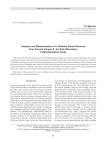
Статья научная
This article describes the methods used in the multidisciplinary study, preservation, and museumization of a wooden structure from a grave under the Early Iron Age kurgan 5 at Pazyryk in the Altai. The structure consisted of two chambers with additional elements on top. Its technological analysis was carried out during the excavations, and the structure was subjected to special treatment after extraction. At the side the mound, the outer cribwork was reconstructed; its details and technologies were evaluated. The stages in the field conservation of all artifacts are described. The museumization of the outer cribwork at the Anokhin National Museum of the Republic of Altai is outlined.
Бесплатно

Analysis of 3D-models of artificially deformed crania, using geometric morphometry
Статья научная
The study of artificially deformed crania is complicated by difficulties in analyzing curvilinear shapes without reliable reference points for measurement. Methods of geometric morphometrics (GM) help to solve this problem. We generated 3D-models of deformed crania (26 male and 19 female) from burials of different chronological periods of the Okunev archaeological culture (Verkhniy Askiz I, Uybat III and V, Uybat-Charkov, Itkol I and II), Southern Siberia (2600–1700 BC). Using the Landmark IDAV software, each model was transformed into a set of six traditional craniometric landmarks and 450 semi-landmarks regularly distributed over the entire surface of the braincase. For further processing with the Procrustes and principal component analysis, functions of several R-packages (Morpho, Geomorph, and Arothron) were employed. Crania from early Okunev burials were found to have a small deformed area around lambda, spanning the posterior parts of parietal bones and the upper part of the occipital squama. In crania from later Okunev burials, the deformation extends on the parietal area, causing the reduction of cranial height owing to a lesser curvature of the parietal segment. The lateral walls of the braincase, the frontal squama, and the lower part of the occipital squama in such crania are more convex.
Бесплатно
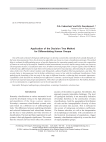
Application of the decision tree method for differentiating human groups
Статья научная
One of the tasks of modern biological anthropology is to develop a system that could objectively classify humanity on the basis of measurements. Here, the decision tree algorithm was chosen to create a classification of groups. The method helps to evaluate the differentiating power of specific dimensions for separating samples and to assess the composition of clusters at each step of the analysis. Standard cranial measurements were used, and the entropy index was chosen as a heterogeneity measure. Classification units were 39 ethno-territorial groups from 13 major regions of the Old World. At the first step, differentiation is made between broad-faced and narrow-faced groups, demonstrating the classificatory value of this trait. The first cluster includes only Mongoloids, admixed Southern Siberian populations, and Ainu. The second cluster is heterogeneous, but its further subdivision is more in line with the traditional classification. Traits underlying the branching of the tree may be the same in different branches, evidencing their taxonomic importance. Capabilities of the decision tree method proved sufficient to construct a system largely similar to the traditional one. Certain traits separate large groups of populations, while others are efficient at the regional level. The method, therefore, can be recommended as a supplementary tool at the intraspecific level.
Бесплатно
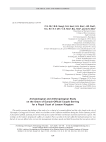
Статья научная
This article presents the findings of the study of a co-burial of a eunuch-official and his wife, found in the city of Uijeongbu, Gyeonggi-do Province, made in accordance with Confucian traditions during the Joseon Dynasty period. A description of finds, perfectly preserved in the grave sealed with lime-soil mixture and charcoal barrier, is given. The writings on the banners draping the coffins are studied. These say that in the left coffin the husband named Lee was buried; he was an official who oversaw the management of palace goods and held the position that was given only to eunuchs. In the right coffin, according to the writing, there was the body of the wife; she was awarded a lady's rank corresponding to her husband's status. Special focus is given to the description of clothes and fabric on the bodies of the buried. The results of anthropological analysis of the remains are given. Morphological features of the pelvic and skull bones provided the information on the sex of the deceased. According to the condition of the auricular surface of the left pelvic bone, the age of the eunuch-official and his wife was determined as more than 60 years. It is concluded that the research materials significantly supplement the scientific information on the position of eunuch-officials in the society during the Joseon Dynasty period.
Бесплатно
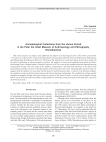
Статья научная
This article presents an analysis and additional description of archaeological items of the Jōmon period from A.V. Grigoriev’s collection (No. 1294) at the Department of Archaeology of the Peter the Great Museum of Anthropology and Ethnography (Kunstkamera) RAS in St. Petersburg. The study focuses on the description of decorative motifs and the stylistic attribution of selected samples of pottery. The analysis is based on the published data about the Ōmori shell mound (Tokyo, Honshu Island), visited by Grigoriev in 1878 as a part of the expedition from the Imperial Russian Geographical Society. The early stage of the Japanese archaeology is described with reference to the Ōmori shell mound. Special attention is given to specific features of the Jōmon decorative style. The geographic location of the site suggests that the samples are associated with the Kasori B and Horinouchi styles. Contrary to the Russian tradition, the emphasis is made on stylistic interpretation rather than technology and typology. The combinations of large zonally arranged rectangular designs and spiral motifs are typical of the Kasori B style, to which several samples belong. Others reveal vertically and horizontally arranged patterns consisting of incised arcuate and straight lines, typical of the Horinouchi style.
Бесплатно

